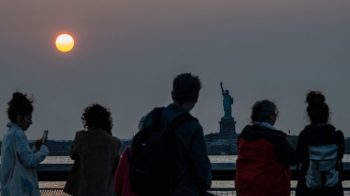
Canada is trying to rebuild its tourism industry

This story was produced by our colleagues at the BBC.
Breathtaking beaches and stunning sunsets. Known locally as “Great Spirit Island,” Manitoulin Island in Ontario isn’t easy to reach. It involves around seven hours of travel, including a two-hour ferry, if you’re coming from Canada’s largest city, Toronto.
Priya and Yashan are on a road trip of Eastern Canada from India. “It’s like a lot of driving here — it took almost three to four hours,” Priya said.
“We saw it on the social media and then we decided that we should come here,” she said.
Canada’s government and tourism industry want more visitors to plan trips like this. Since COVID-19 stopped international travel in 2020, the number of international tourists traveling here is still not what it once was. Travelers from the U.S. are at 85% of 2019 levels and those from further afield are at 78%, according to Destination Canada, the country’s national tourism organization.
This summer, the government unveiled a roadmap to rebuild the tourism industry. One area that is showing promise is Indigenous tourism. Before the pandemic, it was the fastest growing sector in the industry.

On the First Nation reserve of Wikwemikong on Manitoulin, Indigenous culture guide Jack Rivers hosts Wikwemikong Tourism’s daily tours. “Growing up, I was always going to these sites and you were seeing like non-Indigenous people doing our content,” he said, “so to see where we are in this shift and now it is being told by the First Nations people.”
Canada’s government is investing in Indigenous tourism – these are businesses that are majority-owned by First Nations, Métis or Inuit peoples that demonstrate a connection to the land where the work happens. Rivers would like to see the money go to housing.
“Accommodation would be one of the biggest hurdles for a lot of remote tourism operators. Housing is such a big issue right now across the country,” he said. “So I mean, retaining employees, much like a lot of tourism industries is, yeah — where do we house potential employees?”
More than 60% of Canadian tourism businesses are struggling with staffing, according to a recent survey conducted for Tourism Canada.
“I do think that we need to do a better job in terms of promoting the sector and the career opportunities that we have,” said Soraya Martínez Ferrada, Canada’s minister of tourism. “Having the skills and having the training to do that, I think it’s important.”
Another issue facing Canadian tourism is wildfires. In 2023, unusually high temperatures and drought helped fuel the worst wildfire season in the country’s history, burning 37 million acres of land. There were more this year.

Karyn Decore is the president of Decore Hotels, which owns a cafe and two hotels — including Maligne Lodge in the mountainous area of Jasper, Banff.
“Our property, the Maligne Lodge, was completely destroyed. There was a hotel beside it also that is one of the older hotels in Jasper called the Mount Robson. The Mount Robson beside us was completely destroyed, and so we will have to rebuild our hotel,” she explained.
Thankfully, Karyn had insurance and in time will be able to rebuild her hotel. But what is the government doing to ensure tourists will be safe in the future?
“We do want to make sure that people understand that Canada is big — so when you talk to me about Jasper, it’s one thing, but it’s not the whole country that’s on fire,” said tourism minister Martínez Ferrada. “So we have to make sure that travelers understand that as well as there might be threats around climate change, there are so many other places to discover in Canada that they can actually go and look.”
The tourism sector currently brings in close to $220 million a day. The government is aiming to increase that by 50% in the next five years. But how they get there relies on many factors beyond their control.
There’s a lot happening in the world. Through it all, Marketplace is here for you.
You rely on Marketplace to break down the world’s events and tell you how it affects you in a fact-based, approachable way. We rely on your financial support to keep making that possible.
Your donation today powers the independent journalism that you rely on. For just $5/month, you can help sustain Marketplace so we can keep reporting on the things that matter to you.

















